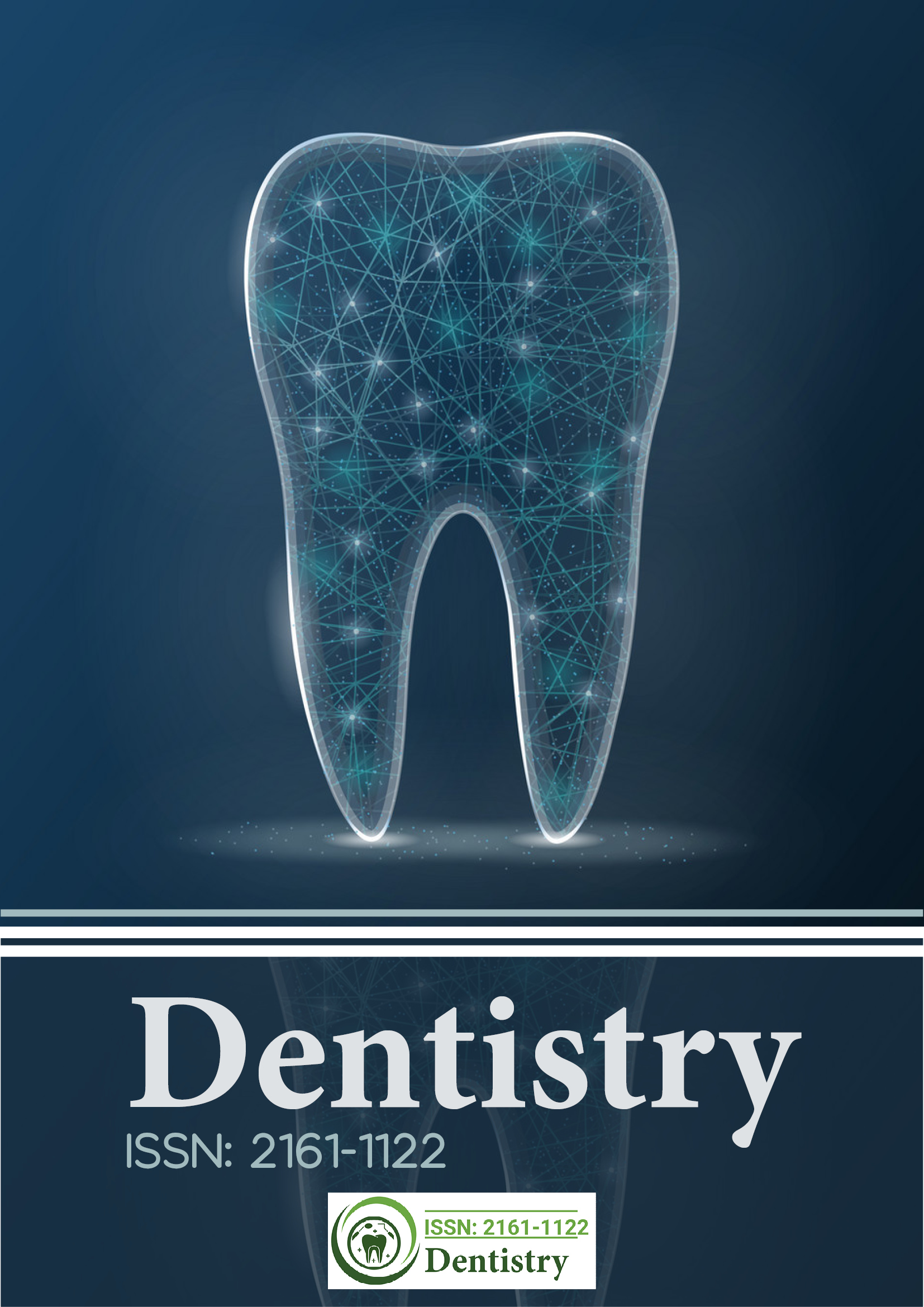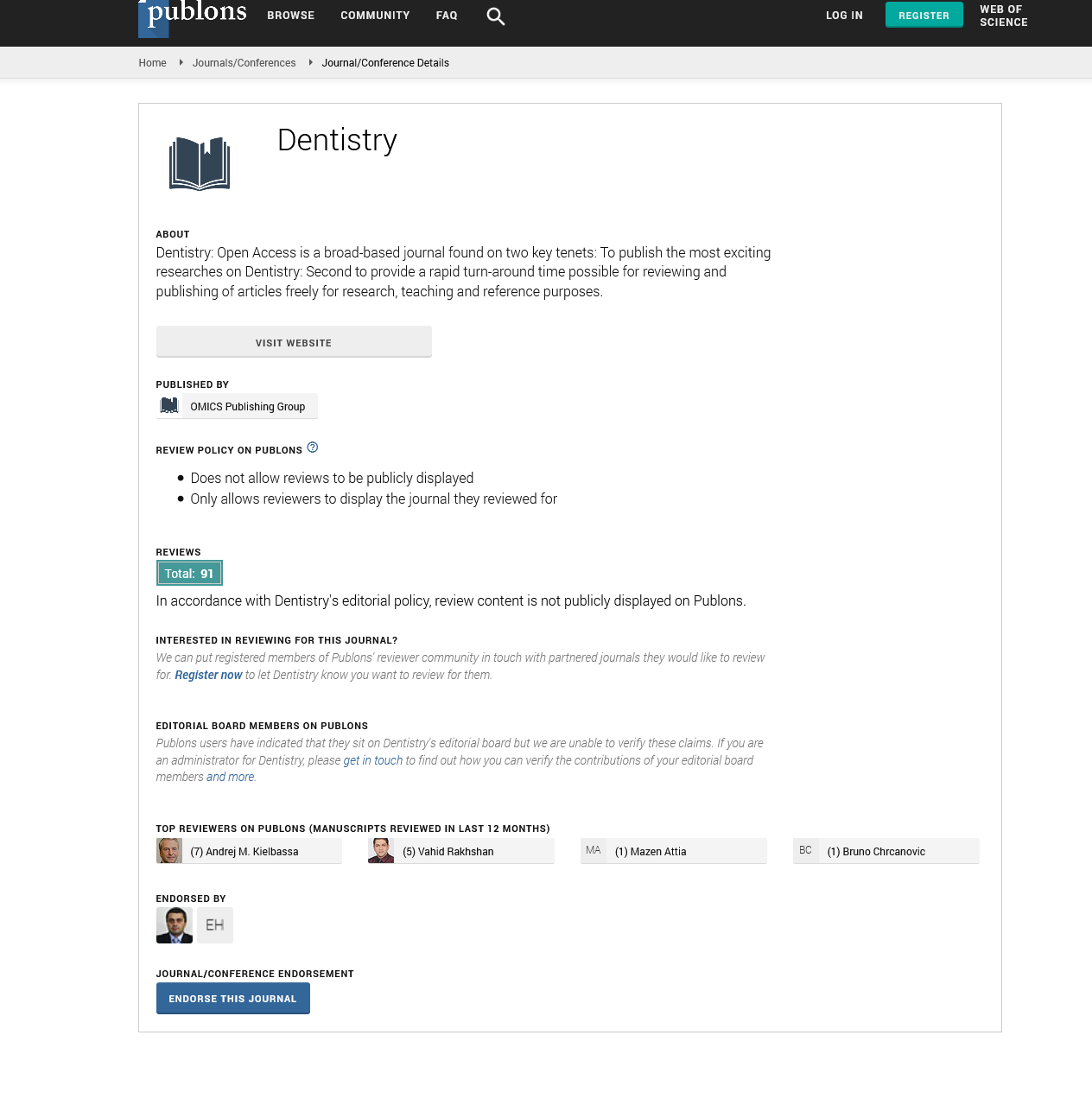Citations : 2345
Dentistry received 2345 citations as per Google Scholar report
Indexed In
- Genamics JournalSeek
- JournalTOCs
- CiteFactor
- Ulrich's Periodicals Directory
- RefSeek
- Hamdard University
- EBSCO A-Z
- Directory of Abstract Indexing for Journals
- OCLC- WorldCat
- Publons
- Geneva Foundation for Medical Education and Research
- Euro Pub
- Google Scholar
Useful Links
Share This Page
Journal Flyer

Open Access Journals
- Agri and Aquaculture
- Biochemistry
- Bioinformatics & Systems Biology
- Business & Management
- Chemistry
- Clinical Sciences
- Engineering
- Food & Nutrition
- General Science
- Genetics & Molecular Biology
- Immunology & Microbiology
- Medical Sciences
- Neuroscience & Psychology
- Nursing & Health Care
- Pharmaceutical Sciences
Short Communication - (2024) Volume 14, Issue 2
Revolutionizing Oral Care through the Evolution of Dental Technology
Dalal Jaber*Received: 03-Jun-2024, Manuscript No. DCR-24-26165; Editor assigned: 05-Jun-2024, Pre QC No. DCR-24-26165 (PQ); Reviewed: 19-Jun-2024, QC No. DCR-24-26165; Revised: 26-Jun-2024, Manuscript No. DCR-24-26165 (R); Published: 03-Jul-2024, DOI: 10.35248/2161-1122.23.14.693
Description
Dental technology has undergone a transformative evolution, revolutionizing the field of dentistry and enhancing the quality of care provided to patients. From the earliest rudimentary tools to the digital technologies, advancements in dental technology have significantly improved diagnostic accuracy, treatment efficacy, and patient comfort. This article delves into the various aspects of dental technology, exploring its historical progression, current state, and future prospects. The history of dental technology dates back thousands of years. Ancient civilizations, including the Egyptians, Greeks, and Romans, utilized basic tools and materials to treat dental problems. Digital technologies have permeated various aspects of dental practice, from diagnostics to treatment planning and performance. One of the most significant breakthroughs in digital dentistry is the development of digital imaging techniques. Digital X-rays have numerous advantages over traditional film-based radiography, including reduced radiation exposure, immediate image availability, and enhanced image quality [1,2].
Intraoral cameras have also become invaluable tools, providing high-resolution images of the mouth that help in patient education and documentation. Computer-Aided Design and Computer-Aided Manufacturing (CAD/CAM) technology have revolutionized restorative dentistry. CAD/CAM systems enable the precise design and fabrication of dental restorations such as crowns, bridges, and veneers. This technology allows for sameday restorations, reducing the number of dental visits required and improving patient satisfaction. Modern diagnostic tools have dramatically improved the ability to detect and treat dental conditions at an early stage. Cone Beam Computed Tomography (CBCT) provides three-dimensional imaging, present a detailed view of the teeth, bone, and surrounding tissues. This technology is particularly useful in complex cases, such as implant placement and orthodontic planning, where precise anatomical information is essential [3,4].
Laser technology has also made significant inroads in dental diagnostics and treatment. Dental lasers can detect cavities at an early stage by measuring fluorescence levels in the teeth. Lasers are also used for soft tissue procedures, such as gum re-shaping and treatment of periodontal disease, offering a minimally invasive alternative to traditional surgical methods. The development of advanced dental materials has played a acute role in improving the outcomes of dental treatments. Traditional materials, such as amalgam, have been largely replaced by more visually attractive and durable alternatives. Composite resins, for instance, suggestion excellent aesthetic results and bond well to tooth structures, making them ideal for fillings and restorations. By performing the translucency of natural teeth, these materials give patients restorations that are both aesthetically pleasing and functionally sound [5,6].
3D printing is another technological innovation that has made a profound impact on dentistry. This technology allows for the creation of highly precise dental models, surgical guides, and even custom prosthetics. 3D printing has streamlined the workflow in dental laboratories, reducing the time and cost associated with traditional manufacturing processes. Custom orthodontic aligners, such as those used in Invisalign treatment, are one of the most notable applications of 3D printing in dentistry. These aligners are created using 3D scans of the patient’s teeth, ensuring a perfect fit and more efficient treatment process. The rise of tele-dentistry has expanded access to dental care, particularly in underserved and rural areas. Teledentistry involves the use of digital communication tools to provide remote consultations, diagnostics, and patient education. This approach not only increases accessibility but also allows for continuous monitoring of patients with chronic conditions, ensuring timely interventions. Remote monitoring devices, such as smart toothbrushes, are now available to track oral hygiene habits and provide feedback to both patients and dentists. These devices can monitor brushing patterns, detect potential issues, and even remind patients of their dental appointments [7,8].
The future of dental technology holds even more potential with ongoing research and development in various fields. Artificial Intelligence (AI) and machine learning are set to play a significant role in dental diagnostics and treatment planning. AI algorithms can analyze vast amounts of data to identify patterns and predict outcomes, potentially leading to earlier detection of dental diseases and more personalized treatment plans. Virtual Reality (VR) and Augmented Reality (AR) are also emerging as valuable tools in dental education and patient care. VR can provide immersive training experiences for dental students, allowing them to practice procedures in a virtual environment. AR can enhance patient consultations by overlaying digital information onto the real world, helping patients visualize treatment outcomes. Nanotechnology is another frontier in dental research. Nanomaterials have the potential to improve the properties of dental materials, making them stronger and more resistant to wear. Additionally, nanoparticles could be used in preventive treatments, such as coatings that protect teeth from decay and infection [9,10].
Conclusion
Dental technology has come a long way from its humble beginnings, driven by continuous innovation and a commitment to improving patient care. The integration of digital tools, advanced materials, and new treatment modalities has transformed the practice of dentistry, making procedures more efficient, effective, and comfortable for patients. As technology continues to advance, the future of dental care looks capable, with the potential for even greater improvements in oral health and patient outcomes. The ongoing evolution of dental technology ensures that both patients and practitioners can look forward to a future where dental care is more accessible, precise, and personalized.
References
- Khoury F, Keeve PL, Ramanauskaite A, Schwarz F, Koo KT, Sculean A, et al. Surgical treatment of peri-implantitis-Consensus report of working group 4. Int Dent J. 2019;69:18-22.
[Crossref] [Google Scholar] [Pubmed]
- Nobre MA, Salvado F, Nogueira P, Rocha E, Ilg P, Maló P. A prognostic model for the outcome of nobel biocare dental implants with peri-implant disease after one year. J Clin Med. 2019;8(9):1352.
[Crossref] [Google Scholar] [Pubmed]
- Javed F, Romanos GE. Chronic hyperglycemia as a risk factor in implant therapy. Periodontol 2000. 2019;81(1):57-63.
[Crossref] [Google Scholar] [PubMed]
- Akutsu Y, Matsubara H, Shuto K, Shiratori T, Uesato M, Miyazawa Y, et al. Pre-operative dental brushing can reduce the risk of postoperative pneumonia in esophageal cancer patients. Surgery. 2010;147(4):497-502.
[Crossref] [Google Scholar] [PubMed]
- Ishikawa S, Yamamori I, Takamori S, Kitabatake K, Edamatsu K, Sugano A, et al. Evaluation of effects of perioperative oral care intervention on hospitalization stay and postoperative infection in patients undergoing lung cancer intervention. Support Care in Cancer. 2021;29:135-143.
[Crossref] [Google Scholar] [PubMed]
- Zarb GA, Schmitt A. The longitudinal clinical effectiveness of osseointegrated dental implants: The Toronto study. Part III: Problems and complications encountered. J Prosthet Dent. 1990;64:185-194.
[Crossref] [Google Scholar] [PubMed]
- Berretin-Felix G, Nary FH, Padovani CR, Machado WM. A longitudinal study of quality of life of elderly with mandibular implant-supported fixed prostheses. Clin Oral Implants Res. 2008;19(7):704-708.
[Crossref] [Google Scholar] [PubMed]
- Engfors I, Örtorp A, Jemt T. Fixed implant-supported prostheses in elderly patients: A 5-year retrospective study of 133 edentulous patients older than 79 years. Clin Implant Dent Relat Res. 2004;6(4):190-198.
[Crossref] [Google Scholar] [PubMed]
- Namvar MA, Afkari BF, Moslemkhani C, Mansoori K, Dadashi M. The relationship between depression and anxiety with temporomandibular disorder symptoms in dental students. Maedica. 2021;16(4):590.
[Crossref] [Google Scholar] [PubMed]
- Converse GL, Li D, Buse EE, Hopkins RA, Aljitawi OS. Wharton’s jelly matrix decellularization for tissue engineering applications. Methods Mol Biol. 2018:25-33.
[Crossref] [Google Scholar] [PubMed]
Citation: Collins J (2024) Role and Benefits of Sedation Dentistry in Transforming Dental Care. J Dentistry. 14:693.
Copyright: © 2024 Collins J. This is an open access article distributed under the terms of the Creative Commons Attribution License, which permits unrestricted use, distribution, and reproduction in any medium, provided the original author and source are credited.

